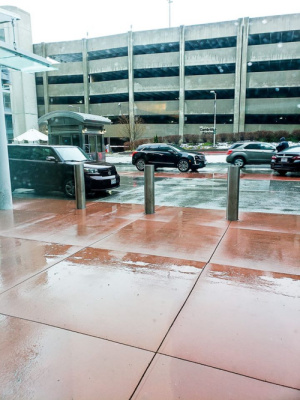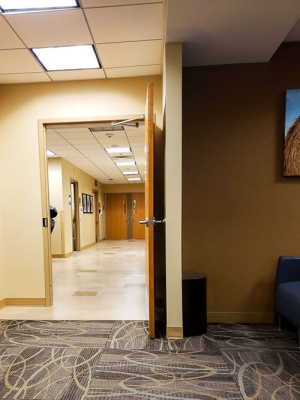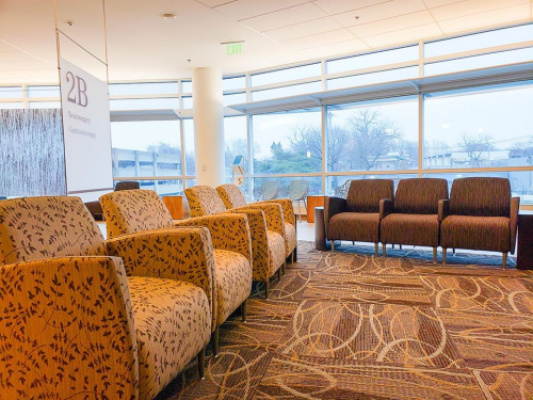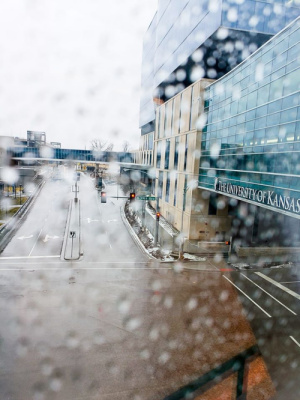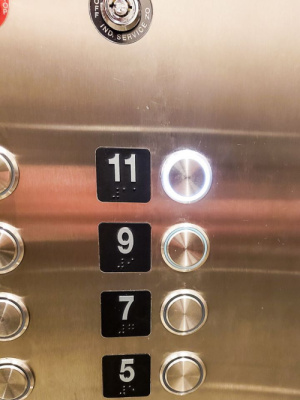Journal entry by Suzanne Schuster —
The surgeon flashes a smile as he enters my exam room and asks how I’m doing today. Dr Pumpkin Cutter wasn’t smiling when we first met a year ago. “I think I’m doing fine, Doc, but let’s look at that MRI scan and see for sure”, I respond, with maybe just a little too much enthusiasm. My anxiety has been building in the last few months and especially in the last couple weeks in anticipation of this important milestone in my brain tumor odyssey. And these last ten minutes waiting in the exam room I’ve felt like a tea kettle approaching boil with a faulty relief valve.
Hope for the best, but brace for the worst. That’s how I approach my medical visits these days, and it’s the best advice I can give to others starting on their own medical journey. It is an attitude I’ve encountered with most cancer survivors, who like brain tumor survivors, tend to live each day with a guarded optimism, but with unguarded gratitude for each and every one we are granted, not knowing if, or when, the unwanted visitor may return and bring an end to our travels. There are no bad days, we realize, only good ones, and each one of them a gift. It’s a shame most folks don’t seem to realize this until they’ve been told by a medical team how many days they might have left, and with astonishment, to roll past “zero day” by the Grace of God and with the help of medical science. Slowly, very slowly, we then see our day counter reverse its downward spiral of time left; and watch it cautiously start counting forwards again.
My day actually began the evening before with a two hour drive down to KU Med’s main hospital. With my MRI scheduled for 7 AM, I plan ahead by staying overnight at the Friendship Inn, a house which provides lodging for patients and families of patients in the hospital next door. It’s a full house, as usual, and I arrive at the same time as a lady who is about my same age. Kathy meets us at the door. She introduces me to the other guest as “the guy who had brain surgery”. I’m amazed she remembers me, but then my wife and I did spend a couple weeks here at the house last summer. As I’m introduced to the other lady, I find out her husband has had an organ transplant, and is having a few issues. Somehow the talk drifts to injections and needles. “I hate needles, they scare me to death. I’m terrified of even getting a flu shot” she exclaims. I’m tired, and also anxious about what tomorrow’s MRI might reveal, so I’m not the best conversationalist. All I can think of is the blood thinner shots every eight hours when I was in the hospital. The ones that feel like somebody just snapped an industrial strength rubber band against your arm, and leave a nice bruise to prove it. Or the round of IV antibiotics that collapsed the veins in my arms to the point that towards the end they were putting IV needles in my hand where there are plenty of nerves to alert the body. But I don’t say anything. One thing I’ve learned over the past six months is that few people much want to hear my war stories. And besides, if the lady is in this place, she’s fighting a war of her own with plenty on her plate and no need to hear how silly a fear of needles sounds to me after my experiences. I excuse myself, and head to my room with the ladies’ conversation receding away as I walk down the hallway.
After a night of fitful sleep, I arrive at the hospital. It’s a huge place, but it’s amazing how quickly I’ve developed a mental map of a hospital that had at first seemed so massive and complicated. I don’t know how many MRI tubes this place has, but this will be my fourth MRI in less than a year here, and I haven’t visited the same MRI room twice yet. These machines look newer, and I suspect faster than my previous ones. First I need an IV needle inserted, as they will inject a metal dye into my blood to make the tumor and other features show up better than with a standard MRI. I’m thinking back to the blood sample I gave a month earlier at our local community hospital as part of my routine annual physical. That time around it took ten minutes, multiple jabs of the needle and a nice hematoma to produce enough blood for the lab work. The tech reads my mind. “If you brought a vein, I’ll find it” she says with a smile. I’m reminded just how good the folks down here really are when she quickly and without seeming effort jabs the needle and hits pay dirt. Then everything magnetic goes into a locker, and before I know it I’m face up with my head clamped in a vice, sliding into a hole that appears to be way too small for a human body to pass through. I was a rookie at this a year ago, but now I’m an MRI veteran. It’s evident to the techs this isn’t my first time on the circus ride. All the while, I’ve been accompanied step by step with another patient. He’s a little older than me, I’d guess early sixties. Even though I’d been clear across the waiting room when he got there, because of both the volume and quantity of his words, I’ve learned that he’s been referred here by the VA. He’s here with his wife, but that doesn’t stop his joking and flirting with the techs and staff. Yep, this JI Joe is a real life of the party here at 6:30 AM in room 2C, outpatient radiology. Or maybe he’s just whistling as he walks past the graveyard.
My MRI tube must have had a “turbo speed” button because I’m done with both non-contrast and contrast MRI runs in 28 minutes. That’s about half the time it’s taken in the other tubes. Whatever the case, it leaves me plenty of time to grab some breakfast, and plenty of time to worry and stew over the possible results of the scan.
The neurosurgeon’s waiting room is mercifully empty at 9 AM. There are two benefits to scheduling your appointment as early as possible in the day, one practical and the other selfish. First, and the practical reason is that the doctors haven’t been delayed yet as you will be their first patient of the day. As the day progresses, there will always be delays, and these will compound with even more delays until by late in the day you might find yourself waiting an extra hour or so past your scheduled time. The other advantage is less practical and more selfish. An empty waiting room isn’t as hard to look at as one full of people with concern etched on their faces, waiting for what will likely be some pretty unwelcome news. I once thought it could be amusing to sit here and scare the bejebbers out of the newbies in the waiting room, with them trying not to stare at the six inch suture scar running vertically down the side of my head and my left eye held slightly more open than my right eye. But it turns out that there’s no joy in that, really. I’m content to just sit in the nearly empty waiting room, staring through the windows into a slate gray late winter day as some sort of frozen precipitation taps on the glass, trying to find a way inside. I’m called by the nurse, and I head towards the exam room and the results of my MRI scan of earlier this morning.
“I’m pleased with the results of the MRI” Dr Pumpkin Cutter says right off. He repeats “very pleased” with that smile of his to which I’ve only recently been introduced. It’s only now that I realize that I’ve been sitting on the edge of my seat in the exam room, and I feel a little silly when I think what I must look like sitting that way. We look at the images on the computer screen as he takes me on virtual tour of the inside of my noggin. About five percent of the tumor is still there, clinging too tightly to nerves and arteries for surgical removal. This is not news. Before surgery, he’d predicted that they would be able to remove about ninety percent of the tumo, and after surgery we found out he’d been able to get a bit more than he expected leaving only that last five percent. And what we’ve all been hoping to see is right there in front of us on the computer screen: No evidence of regrowth in the six months that have passed since surgery.
Dr Pumpkin Cutter explains that we could use directed radiation on the tumor remnants. Or if the facial pain returns, that would be an additional reason to consider radiation treatments. “What are the side effects of the radiation treatments”, I ponder out loud. He pauses, then hesitates slightly before explaining, “The side effects show up ten or fifteen years after treatment” then he trails off again into silence. I have an idea he’s talking cancer, but I don’t have the nerve to ask. At this point, I’m not too keen on finding out anyway. I can’t see much point in hitting that hornet’s nest with a baseball bat just so I can see what might happen. We’ll hold radiation treatments in reserve, and cross that bridge when and if we have to do so. A grade one Meningioma brain tumor like mine could stay dormant for a year, for ten years, even the rest of my life. Or it could start growing again tomorrow. And there’s no way to predict what it will do. Just like the ocean, or a classroom full of kindergartners, you never turn your back on a brain tumor. So the doctor recommends I schedule an MRI and follow up visit for next year.
Meanwhile, my brain tumor will sit there like an old box of leftover dynamite that grandpa threw into the corner of a barn after he finished blowing out tree stumps. Sitting there collecting dust and long forgotten, but remaining potentially very dangerous. Maybe it will go off in a week, maybe it will blow in five years, or just maybe it will still be there until the barn falls in due to natural causes. I’ve heard it said that we all carry within us the seeds of our own destruction. This usually refers to someone’s tendency towards ultimately self-destructive personal behavior. But in my case the seeds are not a metaphor; mine are very real indeed. The seeds of my own destruction are stuck so tightly to the roof of Meckel’s Cave that even a surgeon’s knife couldn’t scrape them off. This is something I will have to learn to accept and live with the rest of my life.
Dr Pumpkin Cutter and I get up to leave the exam room. He extends his right hand, the very same one that was just six months ago poking around in my brain matter. It’s a hand that can work miracles and it’s steady as a rock. He smiles again. We shake hands as I thank him for all he’s done, and we head our separate ways. Chances are I’ve gotten the best news he’ll give out today. Cases like mine are the ones that keep Dr Pumpkin Cutter and his team going. A few rays of sunlight coming through an otherwise solid overcast day. And though the doctor didn’t say it, I suspect he was thinking it: You’re one lucky son of a gun.
I’m at the front desk of the neurosurgery department scheduling next year’s MRI when I notice another patient emerging from an exam room and making his way up the hallway. It’s the JI Joe who was joking and carrying on with the MRI techs this morning. Except that he’s not joking and carrying on now. No, not at all. Actually he looks like he’s just taken a kick from a cow that’s knocked the wind out of him. He walks hunched over, looking down at the floor, with his wife following just behind as the floor seems to crumble out from under his feet more with each step before his wife guides him out of the waiting room. And so, I think to myself, now the real battle begins, soldier. From my seat at the checkout desk, I look across the waiting room. People have started to accumulate in the chairs, some staring off into space and some filling out paperwork. An older couple stands over by the window, facing each other in a two person huddle, each bracing the other up, and speaking in soft tones to one another. I look away, but only to have my eyes come to rest on a young couple. The young lady, clearly distressed, fills out a clipboard full of paperwork. She’s a first timer, I figure, since veterans of the neurosurgeon’s knife like me don’t fill out much paperwork when we come in for checkups. Fate has been busy here, as he is every day. He’s been reaching out with a single bony digit extended, seemingly at random tapping each one these folks on the shoulder. I’ve seen enough. It’s time for me to leave.
My skin cancer checkup isn’t until after lunch, so I drift through the hospital. All the while I’m drinking copious fluids as instructed in order to flush this morning’s injection of liquid metal free from my kidneys. Memories of my stay here come back as I pass familiar landmarks. At the main entrance I pause. The building is inhaling and exhaling people as mass crowds of humanity enter and exit the huge portal. Outside, organized chaos is in progress as vehicles turn, circle around, pause or just plain come to a dead stop in traffic at the main entrance. Add in a little bit of fresh winter ice, and you have a real show going on.
Eventually I float across the Walkway to Heaven and into Cambridge Tower. Soon, I’m in the small lobby near the elevators on the eleventh floor, the one with great views off to the northern part of Kansas City. I’m not alone in the lobby. A lady in her forties is pacing back and forth talking quietly but urgently into her cell phone. In a chair a man sits with his head in his hands, also talking quietly on a cell phone. I walk past them to the windows, but the view isn’t very compelling with a leaden sky. The phone conversations continue in the background. It’s always the same story. Somebody goes to their doctor with something that doesn’t seem too unusual. But then the doctor tells them in a serious tone, “We need to do a few more tests…”, or “I need to refer you to a specialist, he’s one of the best….” And with that not only your life but the life of your family and friends is suddenly put on hold. Everything that seemed so important just yesterday isn’t really that important anymore. You see this same story played out in all the faces you meet up here on the eleventh floor. I had intended to walk the loop and go past the room where I spent some quality time last August. Just like getting back on the horse that has bucked you off, I thought maybe walking Hell’s Hallway could be a good way of putting some of the things I’d seen behind me, the stuff that not a day passes without my mind replaying over again. But I decide today won’t be the day I do that. Maybe I’ll never to do it. I return to the elevator and punch the escape button hard.
My skin cancer checkup isn’t until after lunch, so I drift through the hospital. All the while I’m drinking copious fluids as instructed in order to flush this morning’s injection of liquid metal free from my kidneys. Memories of my stay here come back as I pass familiar landmarks. At the main entrance I pause. The building is inhaling and exhaling people as mass crowds of humanity enter and exit the huge portal. Outside, organized chaos is in progress as vehicles turn, circle around, pause or just plain come to a dead stop in traffic at the main entrance. Add in a little bit of fresh winter ice, and you have a real show going on.
Eventually I float across the Walkway to Heaven and into Cambridge Tower. Soon, I’m in the small lobby near the elevators on the eleventh floor, the one with great views off to the northern part of Kansas City. I’m not alone in the lobby. A lady in her forties is pacing back and forth talking quietly but urgently into her cell phone. In a chair a man sits with his head in his hands, also talking quietly on a cell phone. I walk past them to the windows, but the view isn’t very compelling with a leaden sky. The phone conversations continue in the background. It’s always the same story. Somebody goes to their doctor with something that doesn’t seem too unusual. But then the doctor tells them in a serious tone, “We need to do a few more tests…”, or “I need to refer you to a specialist, he’s one of the best….” And with that not only your life but the life of your family and friends is suddenly put on hold. Everything that seemed so important just yesterday isn’t really that important anymore. You see this same story played out in all the faces you meet up here on the eleventh floor. I had intended to walk the loop and go past the room where I spent some quality time last August. Just like getting back on the horse that has bucked you off, I thought maybe walking Hell’s Hallway could be a good way of putting some of the things I’d seen behind me, the stuff that not a day passes without my mind replaying over again. But I decide today won’t be the day I do that. Maybe I’ll never to do it. I return to the elevator and punch the escape button hard.
Dr Skin bounds into the exam room. “You look younger than you did last year, doc” I greet him. “This guy looks younger every year I see him” I say to his Resident, a tall thin blonde lady in her late twenties. Her skin is so pale it’s almost translucent. I suppose seeing the ravages of skin cancer every day has somewhat of a deterring effect as far as laying out in the sun or going on a tanning bed. “We have special anti-aging creams we use that we don’t tell anybody about” he replies. “Yeah, you guys get to have all the candy” I reply, as his Resident examines my naked body from the bottoms of my feet to the top of my head. “You have boring skin this year” she concludes. Dr Skin then conducts his own exam, and comes to the same conclusion. The talk veers completely to my brain surgery. “You have a real interesting chart” the resident starts out. Then a hundred questions from both Dr Skin and his Resident. I’ve run into this same thing with every medical person I’ve visited since my brain surgery. Family Doc was curious about it at my annual physical. Even my dentist was interested in the recent hole in my head, and we weren’t talking about tooth cavities. I have begun to suspect a lot of folks in the medical field are “closet brain surgery enthusiasts”. Brain surgery is, after all, the final frontier in medical science. Only the very best can—or should—tamper with something that the Good Lord in His wisdom has so carefully and securely bricked up inside our cranium. Yes, indeed, the risks are great and the consequences can be dire when we tamper in God’s domain. Just ask Adam and Eve.
"...with great power there must also come -- great responsibility!” Uncle Ben’s character admonishes Spiderman’s Peter Parker. I should be paying attention to my driving, not mulling comic book platitudes as I head back north towards home. The thermometer is inching downward as the winter rain continues. 33…32…31…30, I watch the outside temperature reading unwind as it is displayed on the truck’s rearview mirror. Its wall to wall trucks on the Interstate, but they are slowing down as the temperature drops, 70…65…60…55. I notice ice forming on my windshield wipers and radio antenna. A few adventurous-- or foolish--drivers whoosh by in the passing lane, apparently oblivious to their car’s slight fishtailing as they roll the dice in life’s ultimate game of roulette.
With all this going on, I should be paying more attention to the road, but I can’t shake the thought that I’ve been handed some great gifts. My vison has returned to near normal, all at once and seemingly miraculously three months after surgery. The acute numbness I had along with slight drooping of the left side of my face after surgery has gradually improved. I’m now only slightly numb in a small area of my lips on the left side and the left side of my nose, and even this continues to improve slowly. I can’t begin to fathom why I’ve been given the gift of time, the gift of health, the gift of life without pain. I’ve managed to live through something that should have killed me. Or at best I should have been consigned to a lifetime of Hellish pain. But I wasn’t. Yes, great gifts indeed, but why? What is my responsibility? This is what my mind ruminates over and over as my driveway finally comes into view. And I continue to ponder it even now.
-
Hospital Main Entrance. It's like this every weekday, year round.This way to the MRI room.Patients and caregivers love hearing from you; add a comment to show your support.Help Harland Stay Connected to Family and Friends
A $25 donation to CaringBridge powers a site like Harland's for two weeks. Will you make a gift to help ensure that this site stays online for them and for you?
Show Your Support
See the Ways to Help page to get even more involved.


